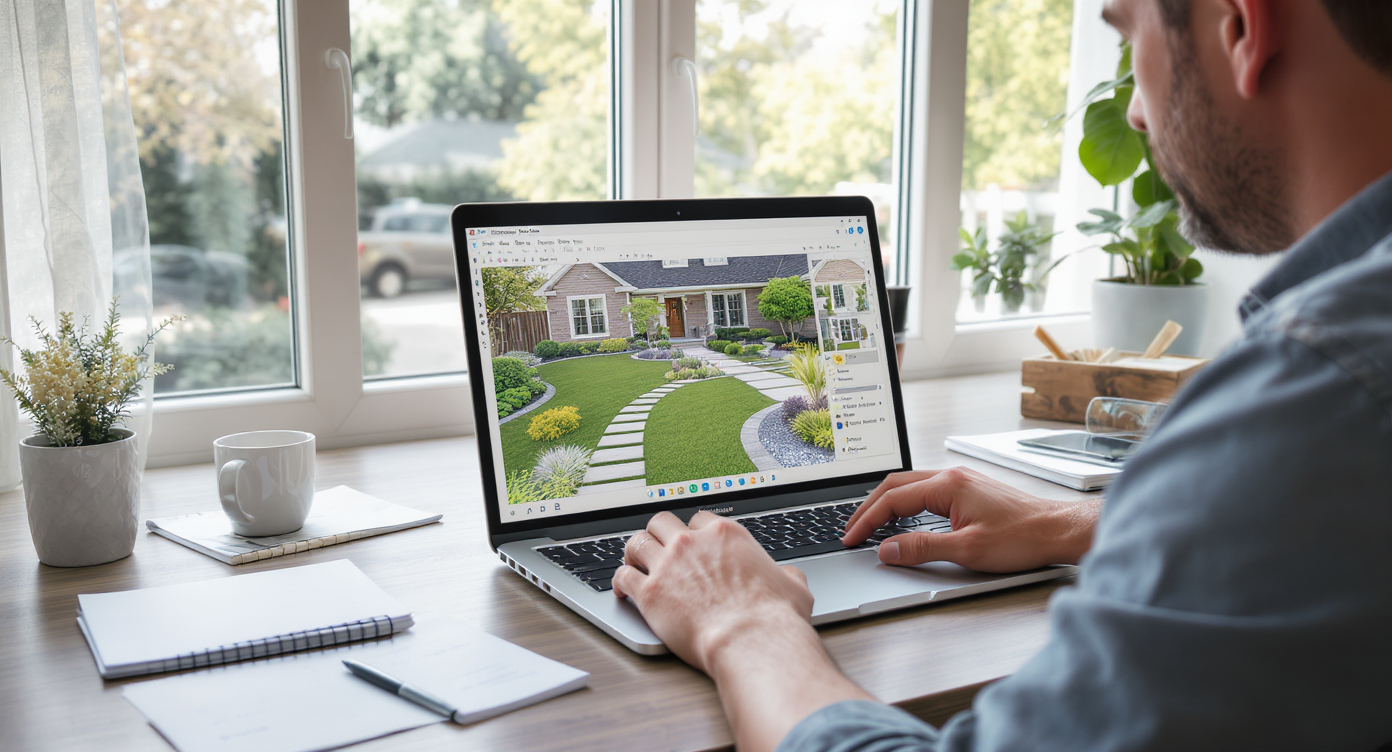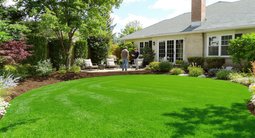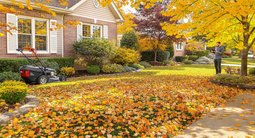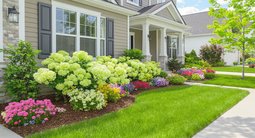TL;DR
Most resilient landscapes thrive on deep, infrequent watering and well-draining soils, not tiny daily sips. Use ReimagineHome.ai to visualize patios, paths, and planting structure so you can fix flow, drainage, and curb appeal before you spend a dollar outside.
72 hours: Deep watering revives stressed plants faster than small daily sips — Introduction

Deep watering revitalizes soil and plants, solving common yard design challenges effectively.
Deep watering and good drainage solve more yard design problems than any miracle ingredient. When dry soils turn hydrophobic, a thorough soak re‑hydrates the root zone, restores turgor, and makes nutrients available; the same principle that perks up a houseplant in 72 hours rescues drought‑stressed borders and lawns outdoors. At a glance: - Landscaping ideas that last begin with soil structure, then hardscaping design. - Hardscaping performs best with a compacted base, proper slope, and consistent path widths. - Privacy planting takes 3–5 years; plan interim screening. - Outdoor lighting looks best at warm 2700–3000 K. - Use an ai landscape design workflow to test layouts before you build. Try your own exterior layout instantly on ReimagineHome.ai: https://www.reimaginehome.ai/?utm_source=blog Alt: “Front yard design with stone walkway, dry creek swale, and layered privacy planting, visualized in ReimagineHome.ai.” Caption: “ReimagineHome.ai lets you compare walkway ideas, drainage swales, and planting masses in minutes.”
2 rules: Water deeply and design drainage first — TL;DR

Water deeply and design drainage first for sustainable, healthy landscaping.
Here’s the short version of a yard that works: - Water deeply, less often. Most drought-tolerant garden design thrives on a thorough soak every 10–14 days in-season, adjusted for heat, wind, and soil. - Fix soil and drainage first. Compacted or hydrophobic soil sheds water like a waxed car; open it up with compost plus mineral aggregate in beds, and direct roof/runoff with a 2% slope away from the house. - Lock in bones with hardscaping design. A stone patio, crisp edging, and a simple path system lift curb appeal and maintenance. - Visualize it before you build with ai outdoor design. ReimagineHome.ai helps you test stone patio shapes, terrace levels, and privacy planting without guesswork.
Anecdote
A homeowner in Phoenix turned a crispy side yard around by ripping out a narrow 18-inch path and installing a 40-inch decomposed granite walk with steel edging. With beds re‑graded to a 2% slope and drip lines set under mulch, the same plants that once wilted now stay upright through 110°F heat—no gimmicks required.
50–70%: Hardscape often dominates low‑maintenance budgets — Why Landscaping & Hardscaping Are Changing

Hardscape often dominates low-maintenance budget, providing polished outdoor living spaces.
Why the shift? Time and water. Homeowners want outdoor living that looks polished without constant upkeep. Hardscape elements—patios, walks, retaining walls—often represent 50–70% of low‑maintenance yard budgets, because they set grade, move water, and reduce weeding. Done right, they partner with climate‑smart planting and drip irrigation to cut water use by 30–50% versus spray systems. The lesson hiding in every “miracle fix” story: tiny sips don’t fix thirsty roots. Outdoors, hydrophobic topsoil after a dry spell can repel water; a slow, deep soak (or temporary use of a wetting agent) re‑primes the profile. Pair that with properly graded hardscape and you’ll see plants respond quickly—and stay that way.
36–48 inches: Path width, 2% slope, and 2700–3000 K lighting — Key Trends You Can Use

Paths with 36–48 inch width, gentle slope, and warm lighting enhance function and style.
Start with measurable moves that boost function and curb appeal: - Path widths: Most landscape architects size primary garden paths at 36–48 inches; secondary paths work at 24–30 inches. This keeps traffic flowing and planting edges tidy. - Slope: Pitch hardscape and lawn at roughly 2% away from the foundation (about 1/4 inch per foot). Add a shallow swale or dry creek to collect and convey stormwater. - Patio base: For a stone patio or pavers, use 4–6 inches of compacted base and about 1 inch of bedding sand before laying; edge restraint prevents creep. - Mulch depth: 2–3 inches of shredded bark or fine gravel reduces evaporation and weeds. - Lighting: Outdoor lighting design typically looks best at 2700–3000 K; use low, shielded fixtures to graze textures and light steps. - Privacy: Hedges and screens often take 3–5 years to mature; mix fast growers for early cover with longer‑lived structure. For modern landscaping ideas for small front yards, keep the layout simple: one generous walkway, one focal tree, a compact stone seating pad, and layered plant masses in three heights. It reads calm from the street and is easy to maintain.
5 steps: Use ReimagineHome.ai to test patios, paths, privacy, and planting — How to Use ReimagineHome.ai

Use ReimagineHome.ai to test patios, paths, and planting layouts before building.
Upload a photo of your home and use these steps to prototype your backyard makeover or front yard makeover ideas: 1) Place structure first. Sketch a stone patio or deck, add a 36–48 inch walkway, and set the 2% slope. ReimagineHome.ai’s ai landscape generator helps you iterate shapes fast. 2) Test drainage cues. Visualize a dry creek swale, a channel drain along the patio, or permeable pavers near downspouts. 3) Layer planting for privacy. Block sightlines with 6–10 foot shrubs at key angles, then infill with grasses and seasonal color. 4) Map lighting. Drop path lights at 8–10 foot intervals, add warm wall washes, and a single downlight over the grill. 5) Stress‑test maintenance. Swap lawn for groundcovers, expand mulch, or add gravel bands around beds to lower edging time. Explore more curb appeal and walkway ideas: https://www.reimaginehome.ai/blogs/curb-appeal-walkway-ideas?utm_source=blog Compare patio materials for a fire pit zone: https://www.reimaginehome.ai/blogs/patio-and-fire-pit-materials-guide?utm_source=blog Plan privacy planting that grows in: https://www.reimaginehome.ai/blogs/privacy-planting-design-tips?utm_source=blog Alt: “Evening stone patio with 2700 K path lights, permeable pavers, and gravel edging, visualized in ReimagineHome.ai.” Caption: “Test hardscaping design, outdoor lighting, and plant massing in one ai backyard design session.”
Visualization Scenario
Upload a straight-on photo of your facade into ReimagineHome.ai. Add a 40-inch paver walkway, extend a stone patio by 2 feet, drop a dry creek to catch downspout flow, and place a trio of 6–8 foot shrubs for privacy. Toggle lighting to 2700 K and compare “lawn vs. groundcover” in one click.
8 quick answers: Watering, soil, materials, and AI landscape design — FAQ
Q: Is milk good for garden plants? A: Not as a routine practice. If dry soil is hydrophobic, a wetting agent and a deep soak help; focus on soil structure, mulch, and consistent deep watering instead. Q: How often should I water a low‑water landscape? A: In established beds, water deeply every 10–14 days in warm weather; new plantings need 2–3 deep waterings per week for the first 2–3 weeks, then taper. Q: What’s the best mix for raised planters or large containers? A: Use a chunky, well‑draining blend: roughly 50–60% mineral aggregate (pumice/perlite), 25% potting soil, 15–25% compost. Ensure big drainage holes. Q: How do I fix hydrophobic soil in garden beds? A: Break crusting, add 2–3 inches of compost, mulch, and apply a slow, deep soak. For severe cases, a biodegradable wetting agent can help re‑hydrate the profile. Q: Best materials for a backyard patio and fire pit? A: For low maintenance, consider concrete pavers or natural stone on a 4–6 inch compacted base. Keep non‑combustible clearances around the pit. Q: Affordable landscaping ideas that still boost curb appeal? A: Widen the front walk to 36–42 inches, add 2–3 inches of mulch, swap one lawn zone for a gravel seating pad, and light the address at 2700–3000 K. Q: How can ai landscape design help me plan? A: ReimagineHome.ai lets you upload a photo, mock up patios, paths, and plant masses, and compare options fast—ideal for testing low‑maintenance hardscaping design. Q: What width should garden paths be? A: Primary paths: 36–48 inches. Secondary paths: 24–30 inches. This keeps movement comfortable and plant edges intact.
1 click: Visualize your home’s next chapter — Curb Appeal Without Guesswork
A homeowner once revived a drooping snake plant by swapping tiny sips for a thorough drink; outside, the same principle scales up beautifully. Deep, rhythmic watering plus correctly built hardscape turns scattered fixes into a coherent outdoor room. When you can see path width, patio size, slope, and planting layers at once—then edit them live—you stop guessing and start designing. Open your photo, try a stone patio, widen the walk, and set the slope line. Then hit compare. Your next chapter is one click away: https://www.reimaginehome.ai/?utm_source=blog
.svg)

.svg)














.png)